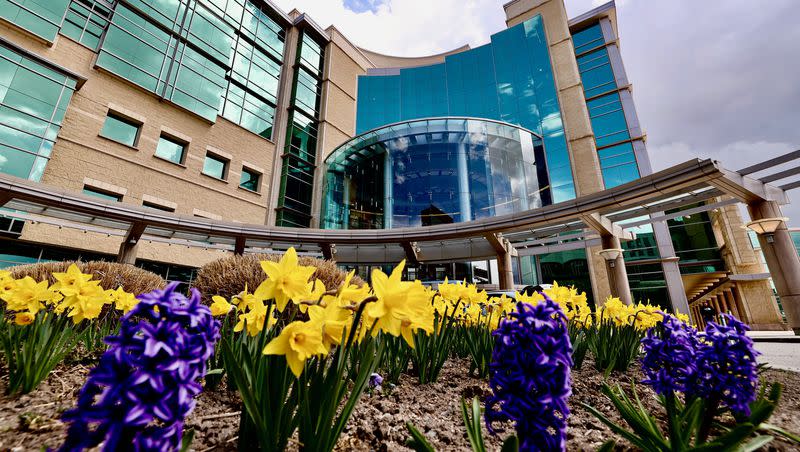Huntsman Cancer Institute will soon exceed 1 million square feet in cancer care, research space

Come June, when the University of Utah Huntsman Cancer Institute opens the new Kathryn F. Kirk Center for Comprehensive Cancer Care and Women’s Cancers, the institute will comprise more than 1 million square feet of space dedicated to patient care and research.
The new facility will expand clinical space by 220,000 square feet, which will include 48 inpatient rooms and four operating rooms along with new patient care spaces for breast, gynecologic, blood and marrow cancers, an endoscopy center and expanded wellness and integrative health center. It also will house work space for oncology faculty.
The new center, to be dedicated May 8, will increase the institute’s inpatient care capacity by 50%, said Dr. Sachin Apte, the institute’s chief clinical officer.
Capacity constraints are a weekly occurrence, which impact patients in Utah but also patients in Montana, Idaho, Wyoming and Nevada, he said. The institute also partners with Grand Valley Oncology in Grand Junction, Colorado.
“With the cancer diagnosis, speed is obviously important,” he said Monday during a meeting with the Deseret News and KSL editorial boards.
Major donors for the Kirk Center include the Spencer and Kristen Kirk family, Huntsman Foundation, Scott and Karen Smith, The Church of Jesus Christ of Latter-day Saints, Sigma Chi International fraternity, doTERRA, Erlynn and J. Christopher Lansing, Khalid and Sally Alturki, and Ashley and Neil Hafer. Some 275 other donors have also contributed.
The Huntsman Cancer Institute is the region’s only National Cancer Institute-designated Comprehensive Cancer Center in the region, which has a total population of about 10.3 million people and is rapidly growing.
Currently, there are some 35,000 cases of cancer annually in the region, and its vast geography poses challenges to people receiving care but also their access to screenings such as mammography and colonoscopies.
Distance is a health disparity. One study by Huntsman Cancer Institute researchers published in the journal Cancer Medicine determined rural Utah residents’ five-year relative cancer survival was 5.2% lower than metropolitan residents with a 10% increase in risk of death.
Ashlee Harrison, the institute’s communication director, said the ongoing challenge is to serve a growing and diverse population so patients in the region have access to high-level care in Salt Lake City and Huntsman caregivers can collaborate with oncologists elsewhere in the region so patients can be monitored and receive ongoing care close to home.
“What can we do to provide cancer care that looks a little bit different to think about the needs of people who have to travel seven or eight hours every time they need to visit us for an appointment,” she said.
Cornelia Ulrich, the institute’s chief scientific officer and executive director of the Comprehensive Cancer Center, said Utah’s experience with cancer is a good news-bad news story.
“We have less smoking. We have less alcohol consumption. We have more physical activity and less obesity, which are all risk factors for cancer. So we’re looking better there than the rest of the nation,” she said.
Melanoma is a different story.
“We’re leading the nation with melanoma because of our high altitude and interest in going (outdoors). That’s a huge factor we need to be mindful of from an early age onward,” she said.
Lung cancer is common, too, “despite our smoking rates being lower than anywhere else,” Ulrich said.
Prostate, colon and pancreatic cancer commonly occur in the Beehive State, as well, she said.
It is unclear if the Utah patterns in the prevalence of particular types of cancer hold in surrounding states because comparable data sets are not yet available but study is ongoing, she said.
The institute’s research arm is learning more about cancer in multiple ways, such as clinical trials, population studies aided by the Utah Population Database and prevention efforts.
One sign of progress is the marked increase in human papillomavirus vaccination rates in Utah. HPV, which is sexually transmitted, can lead to some forms of cancer or genital warts.
“We used to be doing very, very poorly with respect to HPV vaccinations. But thanks to a lot of work from researchers and HCI, we moved from No. 46 and now we’re in the top 20 states,” Ulrich said.
Ulrich said cancer researchers “are at the cusp of the discoveries in immunotherapy, where we know we can finally harness the immune system to fight cancer. A lot of this is getting worked out in a lot of trials. It’s not just melanoma, but now we’re looking at colon cancer. We’re looking at lung cancer. ... Every patient who contributes by participating in a trial helps us to learn and provide the therapies for the next generation of patients,” she said.
Often, patients participating in the trials benefit from the knowledge gained as well, she said.
Apte said some people may perceive that clinical trials are conducted as a “last ditch” effort.
“In cancer, in particular, trials are absolutely integrated. They’re integral and integrated,” he said.
The pace of research has accelerated dramatically in the past 20 years but even more so in the past five years, he said.
“The pace just goes faster and that’s all because of research and how that research translates into clinical trials. For medications, a trial is the best option. I think it’s important to think about trials is, it’s not just something that’s nice to have in cancer, it’s really a must,” Apte said.
Related

